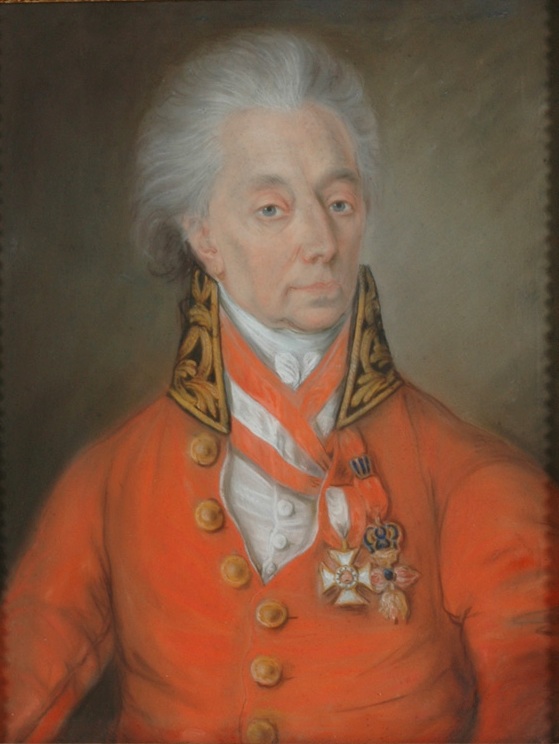Ligne (noble family)

The house (en) Ligne is a uradeliges high noble family from Belgium .
history
The origins go back to the 11th century when the local gentlemen took the name of their area Ligne . Since 1020, this included the Belœil rule . The Lords of Ligne were followers of the Counts of Hainaut and were present at various crusades . A Gautier de Ligne and a Flastre de Ligne fought against the French king in the Battle of Bouvines in 1214 and then had to buy themselves out of captivity. In the 12th century they were raised to barons . Further elevations in the high nobility were in the 16th century to counts of Fauquemberg and princes of Épinoy .
After the counts of Arenberg died out from the house of Count zur Mark , Johann von Ligne founded the so-called Third House Arenberg in 1547 due to his marriage to Margaretha von der Marck- Arenberg (the second house had provided the House Mark after the original Arenbergers died out ).
In 1543 Jacob de Ligne, Charles V's envoy to the Pope, was elevated to the rank of imperial count . Through his wife Marie, the lords of Wassenaer, Valkenburg and Vorburg came to the Ligne house. Lamoral I. de Ligne (1563–1624) from the main line was made Prince of Ligne and Imperial Prince . However, no imperial estate was associated with this. The Ligne family remained Catholic during the Eighty Years' War and was loyal to the Habsburgs. In 1634 it inherited the dominion of Antoing from the Melun- Épinoy , which - like Belœil - has remained in the family to this day. Claude Lamoral I was Viceroy of Sicily and Governor of Milan before he became mentally ill. Claude Lamoral II was Imperial Field Marshal General. The most famous member of the family was the officer and diplomat Charles-Joseph . In 1786 the prince, who was friends with the emperor, was accepted into the Lower Rhine-Westphalian Imperial Counts College of the Imperial Council (and thus the Imperial Estates ) for his County Fagnolles, and in 1803 - because of the Edelstetten Monastery received as compensation for their expropriation - even a virile vote , which it due of the sale to Prince Esterházy in 1804 lost again.
After the Belgian Revolution of 1830, Eugène de Ligne was offered the royal crown, which he refused. The house Ligne belongs to the Salon Bleu and therefore has the right to communicate with the royal family using the pronominal form of address. In addition to the title of Prince of Ligne , the respective head of the family also holds the title of Prince of Amblise and Épinoy, Grande of Spain .
people

- Johann von Ligne (1525–1568), Imperial Count of Arenberg ∞ Margaretha von der Marck-Arenberg
-
Lamoral I. de Ligne (1563–1624), Imperial Prince and 1st Prince of Ligne, diplomat ∞ Marie de Melun
- Ernestine (1594-1668)
- Albert Henri (1615–1641), 2nd Prince of Ligne ∞ Claire-Marie of Nassau-Siegen
- Claude Lamoral I (1618–1679), 3rd Prince of Ligne ∞ Claire-Marie of Nassau-Siegen
- Henri Louis Ernest (1644–1702), 4th Prince of Ligne
- Antoine Joseph Ghislain (1682–1750), 5th Prince of Ligne
- Claude Lamoral II. (1685–1766), 6th Prince of Ligne ∞ Elisabeth Alexandrine zu Salm
- Charles-Joseph (1735–1814), 7th Prince von Ligne, officer and diplomat in the Austrian service ∞ Françoise Marie Xavière von Liechtenstein
- Eugène (1804–1880), 8th Prince of Ligne ∞ Mélanie de Conflans
- Louis (1854–1918), 9th Prince of Ligne ∞ Elisabeth de La Rochefoucauld -Doudeauville
- Ernest (1857–1937), 10th Prince of Ligne ∞ Diane de Cossé-Brissac
- Eugène II. (1893–1960), 11th Prince of Ligne ∞ Philippine de Noailles
- Baudouin (1918–1985), 12th Prince of Ligne ∞ Monique de Bousies
- Antoine (1925–2005), 13th Prince of Ligne ∞ Alix of Luxembourg -Bourbon-Parma
- Michel (* 1951), 14th Prince of Ligne ∞ Eleonora d'Orléans e Bragança
Château d' Antoing
coat of arms
The family coat of arms shows a red sloping bar in gold.
literature
- Eduard Vehse: History of the Small German Courts . Part 6. Hamburg 1857, p. 273-290 .
- Constantin von Wurzbach : De Ligne, Genealogy . In: Biographisches Lexikon des Kaiserthums Oesterreich . 3rd part. Typogr.-literar.-artist publishing house. Establishment (L. C. Zamarski, C. Dittmarsch & Comp.), Vienna 1858, p. 219 ( digitized version ).
Individual proof
- ↑ Catalog des actes de Philippe Auguste , ed. by Léopold Delisle (1856), no.1583, p. 359.



